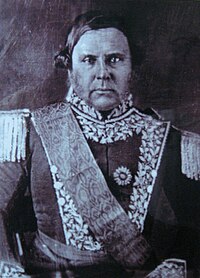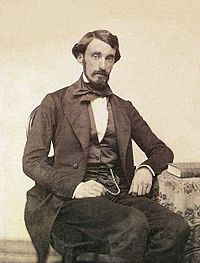Platine War
The war was part of a decades-long dispute between Argentina and Brazil for influence over Uruguay and Paraguay, and hegemony over the Platine region (areas bordering the Río de la Plata).
Although the Governor of Buenos Aires, Juan Manuel de Rosas, had gained dictatorial control over other Argentine provinces, his rule was plagued by a series of regional rebellions.
Rosas backed the Uruguayan Blanco party in this conflict, and further desired to extend Argentine borders to areas formerly occupied by the Spanish Viceroyalty of the Río de la Plata.
In 1851, it allied with the Argentine breakaway provinces of Corrientes and Entre Ríos (led by Justo José de Urquiza), and the anti-Rosas Colorado party in Uruguay.
Turmoil continued in subsequent years, with internal disputes among political factions in Uruguay, a long civil war in Argentina, and an emergent Paraguay asserting its claims.
To achieve reunification, the Argentine government needed to annex the three neighboring countries – Bolivia, Uruguay and Paraguay, as well as to incorporate a portion of the southern region of Brazil.
The Paraguayan dictator José Gaspar Rodríguez de Francia decided that the best way to maintain his own rule and the independence of Paraguay from Argentina was to isolate the country from contacts with the outside world.
President Carlos Antonio López declared war against Rosas and in the first phase of the "Paraguayan front" (1845–1846), Paraguay invaded the Province of Corrientes hoping to cause a rebellion alongside the Argentine dissidents led by Gen. José María Paz, which fared poorly.
In the second phase however (1847–1850), the Paraguayans under Gen. Francisco Solano López occupied the Province of Misiones which was under Rosas' rule, resisting in their positions while suffering heavy losses against the counterattacks of the forces of Buenos Aires.
However, in the final phase of the conflict (1851–1852), President Carlos López refused to join forces with the Allied army, keeping a defensive role (as established with Brazil).
[27] Oribe's control of nearly all of Uruguay had been secured, enabling him to launch an invasion of southern Brazil, his forces stealing cattle, looting ranches, and liquidating political enemies as they went.
[28] Local Brazilians independently decided to retaliate, making raids into Uruguay which became known as "Califórnias",[29][30][31] in reference to the violence in western North America during California's revolt against Mexico, its brief independence and subsequent annexation by the U.S.[32][33] As conflict further escalated with the persistent support of Rosas for the Blancos, anarchy spread over wide areas in the region; with a growing threat to trade, the era's two greatest powers, France and the United Kingdom, were induced to declare war on Argentina and impose a blockade on the Río de la Plata.
These feared Brazil was unprepared for war and that a defeat would lead to a situation similar to the chaos following the loss of Cisplatina in the 1820s, which ended in abdication by Dom Pedro I, the Emperor's father.
[41] Soares made clear his intent to deal with Argentina without foreign assistance, announcing that the "Imperial Government does not desire or judge convenient an alliance with France or any other European nation related to the matters in the Platine region.
Brazil held an advantage in possessing a powerful and modern navy, along with an experienced professional army hardened by years of internal and external warfare.
Luís Alves de Lima e Silva, the Count of Caxias, assumed the presidency (governorship) of Rio Grande do Sul and the command of the four Brazilian Army divisions headquartered in the province.
On 1 May 1851, the province of Entre Ríos, still governed by Urquiza, declared to Rosas that "it is the will of its people to re-assume the entire exercise of its own sovereignty and power which had been delegated to the governor of Buenos Aires."
[30] Urquiza would command the Argentine forces and Eugenio Garzón would lead the Colorado Uruguayans, with both receiving financial and military aid from the Empire of Brazil.
[60] The Brazilian Army entered Uruguay in three groups: the main force, consisting of the 1st and 2nd divisions left from Santana do Livramento—around 12,000 men under Caxias's personal command.
Realising that the Brazilians were approaching and knowing that there was no hope of victory, Oribe ordered his troops to surrender without a fight[48] on 19 October,[54] and retreated into seclusion on his farm in Paso del Molino.
[63] On 21 November the representatives of Brazil, Uruguay, Entre Ríos and Corrientes then formed another alliance[66] in Montevideo with the objective of "freeing the Argentine people from the oppression it suffers under the tyrant rule of Governor Rosas".
The first of these groups was composed of Uruguayan and Argentine troops, along with the 1st Division of the Brazilian Army under Brigadier General Manuel Marques de Sousa (later the Count of Porto Alegre).
It was initially based in the town of Colonia del Sacramento in the south of Uruguay across the Río de la Plata estuary from the city of Buenos Aires.
The Argentines had formed a powerful defensive line at The Tonelero Pass, near the cliffs of Acevedo, protected by 16 pieces of artillery and 2,000 riflemen under the command of general Lucio Norberto Mansilla.
This second influx of ships caused Mansilla and his soldiers to withdraw in chaos, abandoning their artillery, believing that the Allies were intending to land and attack their positions from the rear.
Eugenio Garzón and the Uruguayan troops were taken from Montevideo up to Potrero Perez by Brazilian warships and continued on foot until arriving at Diamante on 30 December 1851, when all the Allied forces were finally reunited.
On 29 January, the Allied vanguard defeated a force of 4,000 Argentines led by two colonels which General Ángel Pacheco had sent to slow down the advance at the Battle of Alvarez Field.
The parades included the Brazilian Army, which insisted that their triumphal procession take place on 20 February, to mark payback for the defeat it had suffered at the Battle of Ituzaingó twenty five years before on that date.
[79] In a period of three years, the Empire of Brazil had destroyed any possibility of reconstituting a state encompassing the territories of the old Viceroyalty of the Río de la Plata, a goal cherished by many in Argentina since independence.
[k] The country came out of the conflict with its monarchy strengthened and the cessation of internal revolts, including in the province of Rio Grande do Sul,[77] entering into a period of economic and cultural prosperity.










